ADATA SE730, SV620 and SC660 External SSDs Review
by Ganesh T S on November 4, 2016 2:15 PM ESTPerformance Evaluation
Our performance evaluation scheme for direct-attached storage devices first takes a look at some synthetic benchmarks, followed by real-world use-cases. Prior to getting into the details of the benchmarks, we take a look at the testbed used to evaluate the external SSDs.
Testbed Setup and Testing Methodology
Evaluation of DAS units on Windows is done with the testbed outlined in the table below. For devices with a USB 3.1 Gen 2 (via a Type-C interface) connections (such as the ADATA SE730 250GB that we are considering today), we utilize the USB 3.1 Type-C port enabled by the Intel Alpine Ridge controller. It connects to the Z170 PCH via a PCIe 3.0 x4 link. For devices with a Type-A interface (via the supplied cable - such as the SC660 and SV620 presented in this review), we utilize a Type-C male to Type-A female converter cable rated for operation at USB 3.1 Gen 2 speeds.
| AnandTech DAS Testbed Configuration | |
| Motherboard | GIGABYTE Z170X-UD5 TH ATX |
| CPU | Intel Core i5-6600K |
| Memory | G.Skill Ripjaws 4 F4-2133C15-8GRR 32 GB ( 4x 8GB) DDR4-2133 @ 15-15-15-35 |
| OS Drive | Samsung SM951 MZVPV256 NVMe 256 GB |
| SATA Devices | Corsair Neutron XT SSD 480 GB Intel SSD 730 Series 480 GB |
| Add-on Card | None |
| Chassis | Cooler Master HAF XB EVO |
| PSU | Cooler Master V750 750 W |
| OS | Windows 10 Pro x64 |
| Thanks to Cooler Master, GIGABYTE, G.Skill and Intel for the build components | |
The full details of the reasoning behind choosing the above build components can be found here. The list of DAS units used for comparison purposes is provided below.
- ADATA SE730 250GB
- ADATA SV620 480GB
- ADATA SC660 240GB
- Netac Z5 512GB
- Samsung Portable SSD T3 2TB
- SanDisk Extreme 500 240GB
- SanDisk Extreme 510 480GB
- SanDisk Extreme 900 1.92TB
Synthetic Benchmarks - Crystal DiskMark
ADATA claims read and write speeds of 550 MBps and 450 MBps respectively for the SE730. The corresponding numbers for the SC660 an SV620 are 420 MBps / 440 MBps. The access traces that can back up those numbers are unfortunately not very common in real-life scenarios.
CrystalDiskMark, despite being a canned benchmark, provides a better estimate of the performance range with a selected set of numbers. As evident from the screenshot below, the performance can dip to as low as 20 MBps for 4K random reads in the SE730.
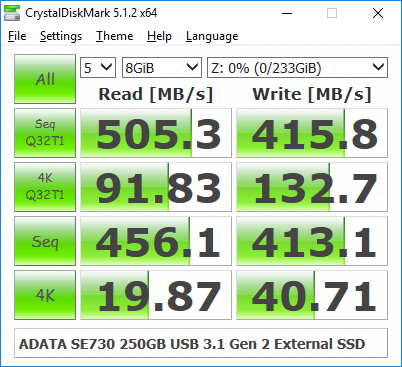
A comparison of the 4K random access numbers at low and high queue depths can also reveal UASP (USB-attached SCSI protocol) support. If the high queue depth numbers are significantly higher than the single outstanding transaction version, it implies that the DAS device supports native command queueing (NCQ) that is possible only if the bridge chip supports UASP. From the above numbers, it is clear that the SE730 supports UASP, while the SV620 and SC660 do not support the feature.
Benchmarks - robocopy and PCMark 8 Storage Bench
Our testing methodology for DAS units also takes into consideration the usual use-case for such devices. The most common usage scenario is transfer of large amounts of photos and videos to and from the unit. The minor usage scenario is importing files directly off the DAS into a multimedia editing program such as Adobe Photoshop.
In order to tackle the first use-case, we created three test folders with the following characteristics:
- Photos: 15.6 GB collection of 4320 photos (RAW as well as JPEGs) in 61 sub-folders
- Videos: 16.1 GB collection of 244 videos (MP4 as well as MOVs) in 6 sub-folders
- BR: 10.7 GB Blu-ray folder structure of the IDT Benchmark Blu-ray (the same that we use in our robocopy tests for NAS systems)
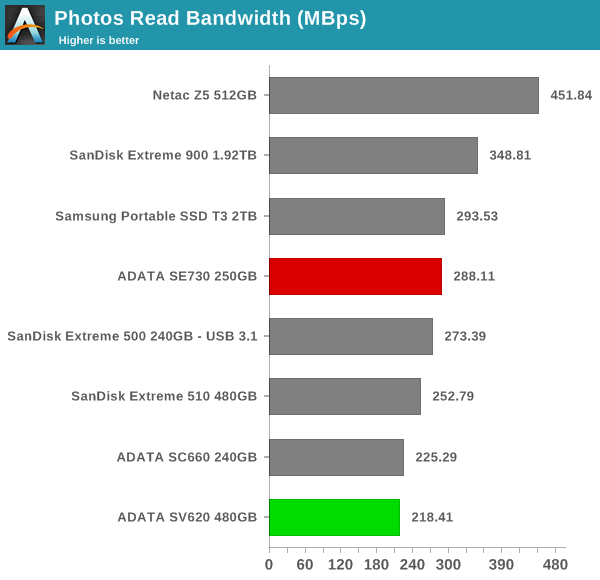
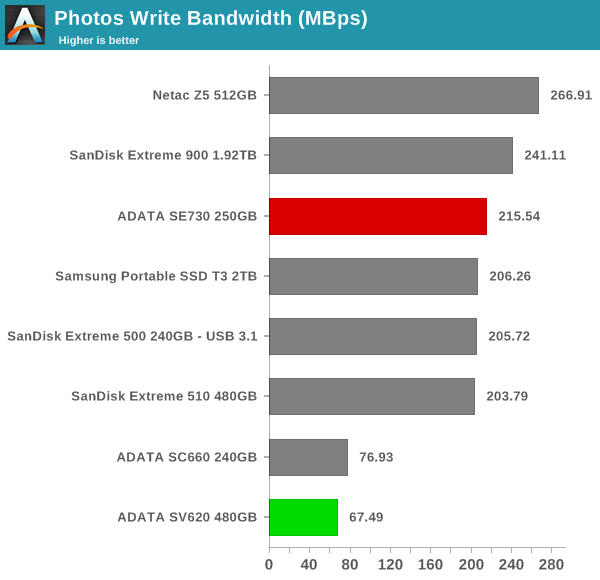
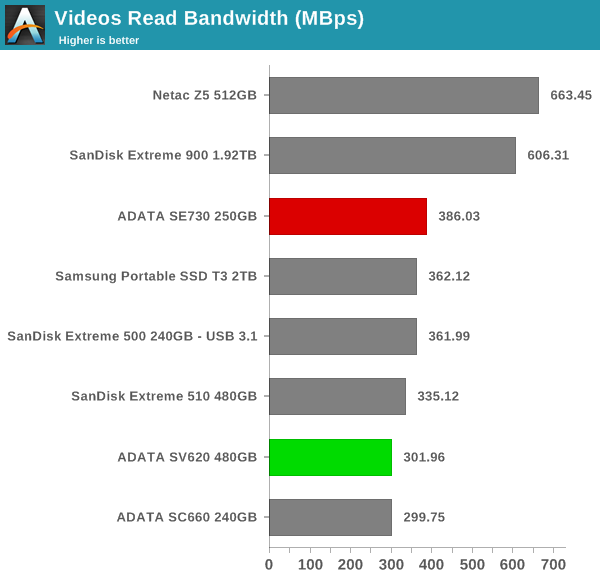

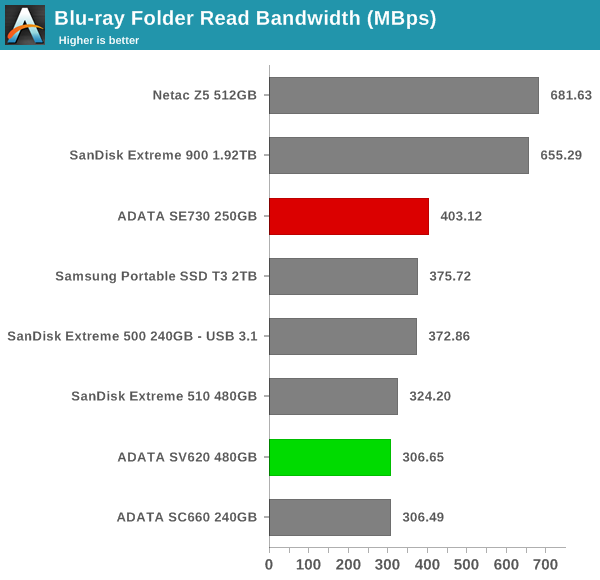
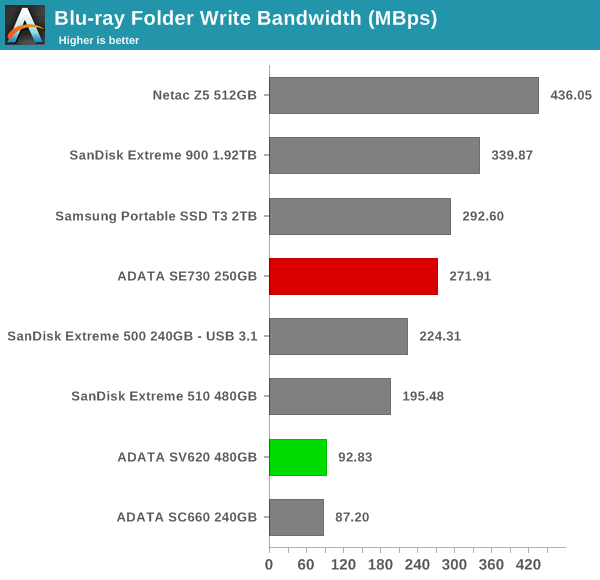
For the second use-case, we take advantage of PC Mark 8's storage bench. The storage workload involves games as well as multimedia editing applications. The command line version allows us to cherry-pick storage traces to run on a target drive. We chose the following traces.
- Adobe Photoshop (Light)
- Adobe Photoshop (Heavy)
- Adobe After Effects
- Adobe Illustrator
Usually, PC Mark 8 reports time to complete the trace, but the detailed log report has the read and write bandwidth figures which we present in our performance graphs. Note that the bandwidth number reported in the results don't involve idle time compression. Results might appear low, but that is part of the workload characteristic. Note that the same testbed is being used for all DAS units. Therefore, comparing the numbers for each trace should be possible across different DAS units.
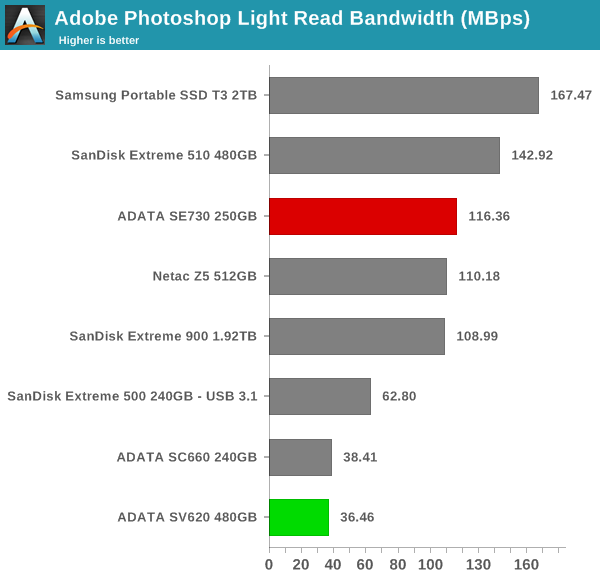
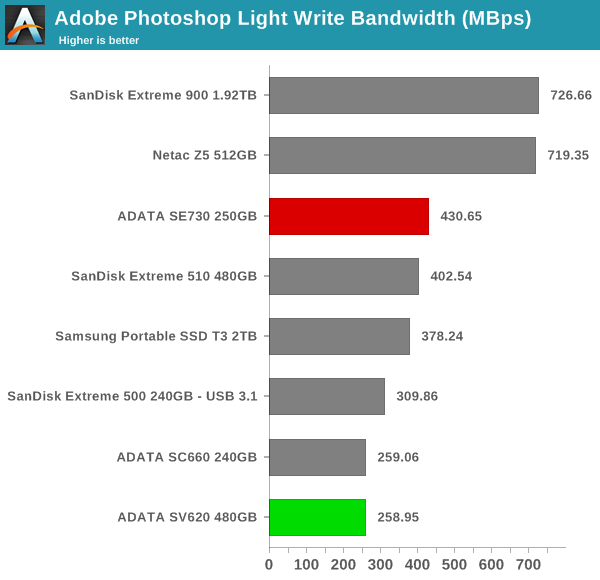
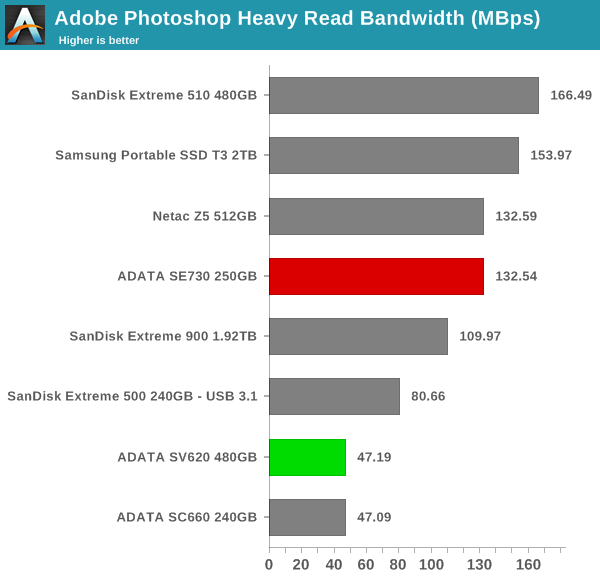
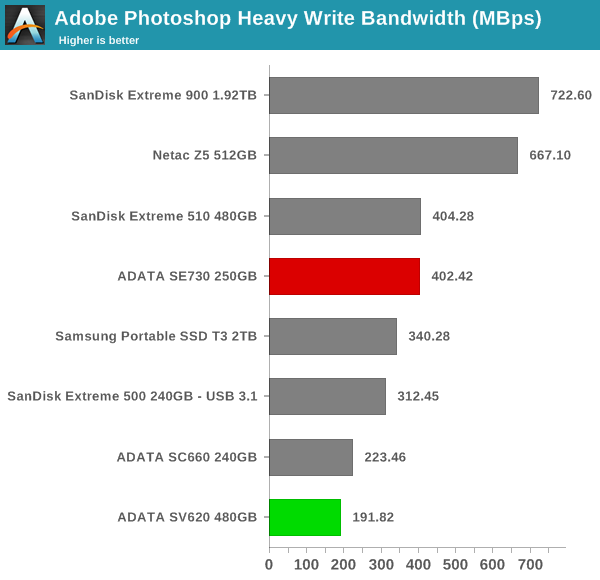
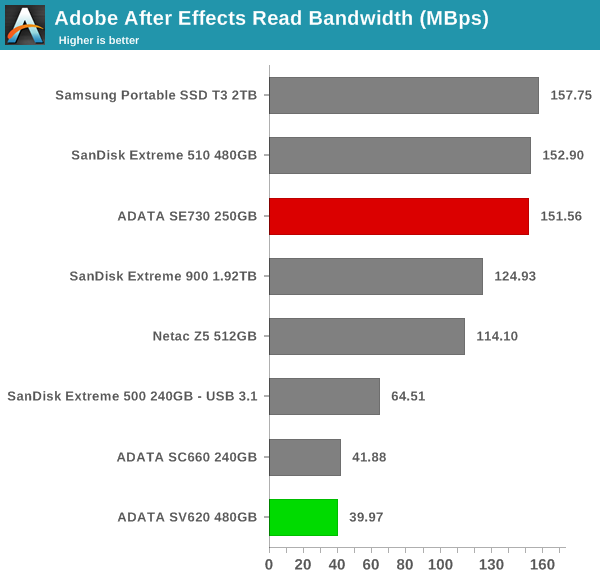
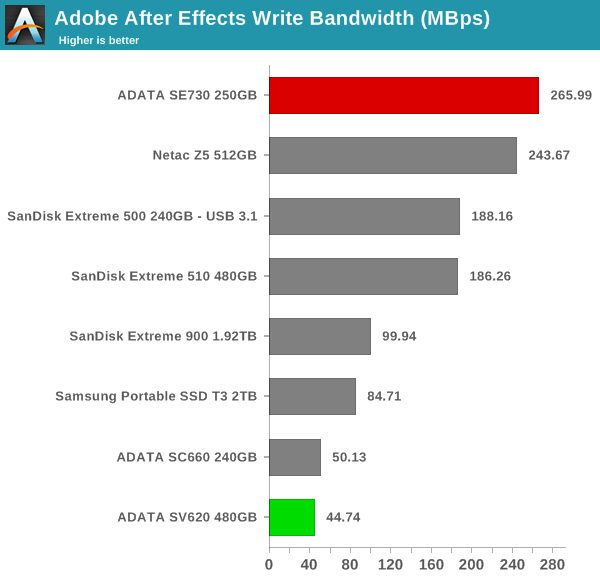
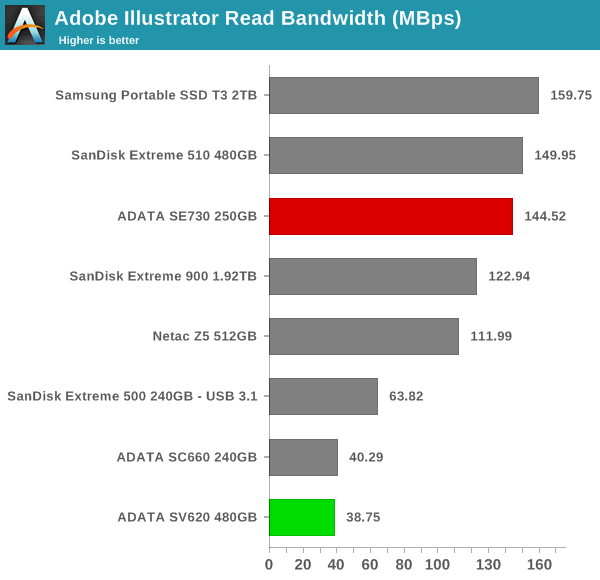
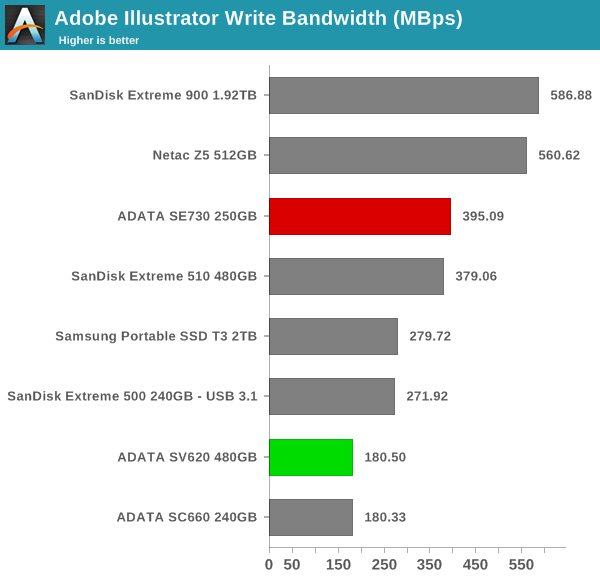
The above benchmark numbers confirm our suspicions - the SV620 and SC660 perform very similar to each other and have significant penalty in scenarios involving sustained writes. The SE730 performs very nicely - comparable to other devices with a single SATA SSD inside them. The use of a USB 3.1 Gen 2 bridge chip enables it to come out with slightly better performance than most of the other USB 3.0-based external SSDs. Devices with RAID 0 SATA drives (such as the Netac Z5 and the SanDisk Extreme 900) perform better in most DAS workloads, but, that is expected.










9 Comments
View All Comments
stephenbrooks - Friday, November 4, 2016 - link
The construction of the SE730 is quite interesting because if the user didn't want it external any more they could plug the M.2 2242 module into their motherboard? I wonder if you could put a different M.2 drive in the casing?zodiacfml - Sunday, November 6, 2016 - link
Thinking the same thing....but I don't see myself purchasing such as these drives are more expensive and large compared to thumb drives to be used as portable storage. Working pros will benefit from the performance of these external drives.Wardrop - Monday, November 7, 2016 - link
Performance is definitely the main reason you'd be a drive like this. Been considering buying an external SSD for my Mac to bring it a little closer to performance to the internal SSD.Michael Bay - Saturday, November 5, 2016 - link
What about data retention? Such drives can spend a lot of time unplugged, I think, so it becomes actuall important.BrokenCrayons - Tuesday, November 8, 2016 - link
That's a good question. It's probably more of a concern for TLC models, but I can't imagine there's a way for Ganesh to test long term data retention and still write a review in a timely manner.pberger - Monday, November 7, 2016 - link
I just bought a new 4TB 2.5" external HDD (Seagate backup plus) for just under $100.Those SSD drives are about 10x more expensive, I pass!
Ithaqua - Monday, November 7, 2016 - link
Give it time.I'm replacing 2@2TB & 1@4TB with 2@8TB external HDD drives (I'd go 10 or 12TB if I could find them cheap).
But when I got the 1st 2TB the cost would be 50-100X for SDD. Now it's 10-20X for SDD. When it gets down to 4x (for me at least) that extra speed with USB 3.1 or 4.0 (or whatever it will be) will be a deciding factor.
BrokenCrayons - Tuesday, November 8, 2016 - link
Yup, for mass storage, it'll be a while before SSDs catch up in cost effectiveness, but I do think that since hard drive sales are slowing down, less R&D budget will be dedicated to capacity increases and mass production benefits will be more difficult to realize due to declining demand. It certainly looks like solid state storage is poised to catch up sooner or later.Like Mikey Bay mentioned in an above post, there's still some data retention problems with current NAND technologies and there's the write endurance problem too in some halo use case situations. For the next few years, I can't see mechanical hard drives going away since they have some small advantages in that respect as long as speed isn't a concern.
I've got to mention that I like solid state external storage though. I had a 120GB BP4 mSATA drive that came out of a laptop that failed. I popped the drive into a tiny USB 3.0 enclosure and it's nice to have something a little quicker than a standard thumb drive that's also pretty much drop-proof to shuffle files around. It's currently serving as a backup disk for documents, photos, and that sort of junk and it does the job nicely.
Ethos Evoss - Sunday, November 13, 2016 - link
Another pointless external ssd enclosure which will NEVER support TRIM as it is via USB interface..Such marketing..